
TM
1
HotWire 5030 POTS Splitter Customer Premises
Installation Instructions
Document Number 5030-A2-GN10-10
October 1997
Before You Begin
Verify that:
The local loop POTS service is connected to the POTS/DSL network at the
punchdown block or network interface device (NID).
New or existing unshielded twisted-pair wiring (CAT3 or better) is used with
this product. The CAT3 wiring must meet EIA/TIA-568 specifications with
24 AWG (.5 mm) or 26 AWG (.4 mm).
For RADSL (Rate Adaptive Digital Subscriber Line) RTU installation information, refer to
the appropriate RTU document:
Document Number Document Title
5216-A2-GN10
HotWire 5216 Remote Termination Unit (RTU)
Customer Premises Installation Instructions
5246-A2-GN10
HotWire 5246 Remote Termination Unit (RTU)
Customer Premises Installation Instructions
5446-A2-GN10
HotWire 5446 Remote Termination Unit (RTU)
Customer Premises Installation Instructions
Package Checklist
Verify that your package contains the following:
POTS splitter and housing with closure screw
Small plastic bag with two 8–15 x 1″ Type A combination Phillips/slotted-head
screws and two 1″ plastic anchors
Warranty card
Tools Required
Flat-blade screwdriver to tighten terminal screws
3/8″ nut driver to close housing securely
Phillips-head or combination Phillips/slotted-head screwdriver to mount the housing
Drill and 3/16″ drill bit to mount the housing in cement or cinder block

2
What Does the POTS Splitter Do?
The POTS splitter and HotWire Remote Termination Unit (RTU) are components in the
RADSL Access System. This system provides high-speed Internet or corporate LAN
access over traditional twisted-pair copper telephone wiring.
The POTS splitter filters out the DSL signal and allows the POTS frequencies to pass
through. The RADSL RTU and telephone can function simultaneously over the same
pair of copper wires at the customer premises when a POTS splitter is used at both
ends of the local loop.
Copper pairs run from the central office to the customer premises to create the local
loop. The local loop terminates on the customer premises at the demarcation point in a
punchdown block or NID.
Wiring is connected from the demarcation point to the POTS splitter and to the DSL
jack. Wiring also connects the demarcation point to an RJ11 wall jack for DSL access
by the RTU.
97-15346-01
Punchdown
Block or NID
DSL
Jack
RTU
New Wiring Connections Existing Wiring (POTS)
Customer Premises (CP)
DSL
Ethernet
Crossover
Cable
Ethernet
Cable
or
Central
Office
(CO)
Demarcation
Point
Local Loop
HUB
CP
POTS
Splitter
DSL - Digital Subscriber Line POTS - Plain Old Telephone Service
NID - Network Interface Device RTU - Remote Termination Unit
POTS
End-user
Systems
Network
Service
Provider
(NSP)

97-15247
POTS Splitter Housing
3
Mounting the POTS Splitter Housing
The POTS splitter can be placed:
H On the outside of the structure near the NID or punchdown block, or
H Inside the building.
When mounted outside, the POTS splitter must be installed at or above the height of
the NID, and should be a minimum of three feet above ground.
At the front of the housing, align the housing to open from the right with the rubber
grommet for cable access facing downward. Place the housing upright as shown. Use a
Phillips-head or combination Phillips/slotted-head screwdriver and the screws included
in the package.
If mounting to:
H Cement or cinder block: use a drill and
and 3/16″ masonry drill bit to install the
two plastic anchors first. Then, install the
two 8–15 x 1″ Type A screws.
H Wood: install only the two 8–15 x 1″
Type A screws and discard the
plastic anchors.

97-15437-01
Lever
Closure
Screw
4
Preparing the POTS Splitter
" Procedure
1. Unscrew the closure screw and open
the housing by pressing on the lever
on the right above the closure screw.
2. Remove the rubber grommet at the base
of the POTS splitter.
3. Make a small diagonal cut in the rubber
grommet to feed the wiring through.
4. Replace the rubber
grommet at the
base of the POTS splitter.
P1 P2 P3 P4
97-15256
Rubber
Grommet
Base of
POTS Splitter

5
Installing the POTS Splitter Wiring
The local loop ends at the punchdown block or NID. Wiring must be connected from the
customer premises (CP) side of the punchdown block or NID to the DSL jack. Typically,
the punchdown block is installed in commercial locations and the NID is installed in
residential locations.
The following is an example of a punchdown block.
ABCD
DSL/POTS
From Local
Loop
Wiring to
DSL Jack
Bridge Clip
Punchdown Block
97-15349
Jumper
Wiring to
POTS Splitter
for POTS
Demarcation Point
Customer Premises
" Procedure
1. Access the punchdown block or NID.
2. Disconnect the POTS access wiring from the local loop.
!
WARNING:
Do not continue unless the DSL access line from the local loop has been
disconnected at the NID or punchdown block. Refer to
Important Safety
Instructions,
page 10.
Green (T1) and Red (R1) are the standard pair wiring colors used in the next two
NID illustrations for Tip (T1) and Ring (R1). Your wiring may differ.

6
DSL/POTS
From Local
Loop
Telephone Network Interface Device (NID)
Ground
Tip
T1
(Green)
Ring
R1
(Red)
97-15502
Existing POTS
Wiring to
Telephone
Demarcation Point
Customer Premises
3. Disconnect the POTS wiring to the telephone from the T1/R1 connectors on the
customer premises side.
4. Feed the disconnected POTS wiring through the POTS splitter rubber grommet
access opening created at the base of the POTS splitter. Connect the wiring to the
right side labeled PHONE. Attach green to P3 and red to P4. Tighten both terminal
screws with a flat-blade screwdriver.
97-15257a
P1 P2 P3 P4
LINE PHONE
Red
Green
To
Telephone
POTS Splitter

7
Reconnecting to the Local Loop
" Procedure
1. Feed new jumper wiring through the POTS splitter rubber grommet. Remove the
insulation at the end of the wiring.
2. On the left side labeled LINE, attach red to terminal screw P1 and green to terminal
screw P2. Tighten both terminal screws with a flat-blade screwdriver.
97-15257-01
P1 P2 P3 P4
LINE PHONE
Red
Red
Green
Green
New Wiring from
Punchdown
Block or NID
To
Telephone
POTS Splitter

97-15251
Lever
Closure
Screw
8
3. Locate the T1/R1 connectors on the customer premises side of the punchdown
block or NID where the existing POTS wiring was removed in Step 3 on page 6.
Attach the jumper pair from P1/P2 labeled LINE in the POTS splitter to the T1/R1
connectors.
DSL/POTS
From Local
Loop
Wiring to
DSL Jack
Telephone Network Interface Device (NID)
Ground
Tip
T1
(Green)
97-15341
Jumper Wiring to
POTS Splitter
for POTS
Demarcation PointCustomer Premises
Ring
R1
(Red)
4. Snap the lever shut to
close the POTS splitter.
5. Use the 3/8″ nut driver
on the closure screw to
securely close the housing.

9
DSL Access Wiring
" Procedure
1. Attach new wiring to the T1/R1 connectors that will go to the DSL jack from the
punchdown block or NID.
2. Tighten the T1/R1 terminal screws with a flat-blade screwdriver.
97-15485
DSL
RJ11
Jack
Central
Office
Punchdown
Block or NID
Customer Premises
POTS/DSL
Local Loop
Demarcation Point
Twisted
Pair Wiring
POTS Splitter
You are now ready to run the specified wiring to the RTU location and install a DSL wall
jack. To install an RTU, refer to the
HotWire 5446 Remote Termination Unit (RTU)
Customer Premises Installation Instructions.
If the RTU is not being installed at this time, reconnect the local loop wiring at the
demarcation point.

10
5030 POTS Splitter Technical Specifications
Item Specification
*
Height x Width x Depth 6.65″ x 5.44″ x 2.25″ (16.89 cm x 13.82 cm x 5.72 cm)
Weight 10.2 ounces (289.2 grams)
Approvals
FCC Part 68
Safety Certifications
Refer to the equipment’s label for Registration Number.
Refer to the equipment’s label for approvals on product.
Physical Environment
Operating temperature
Storage temperature
Relative humidity
Shock and vibration
–40°F to 140°F (–40°C to 60°C)
–40°F to 158°F (–40°C to 70°C)
5% to 95% (noncondensing)
Withstands normal shipping and handling
Interface Connectors Four terminal screws
*
Technical Specifications subject to change without notification.

11
Important Safety Instructions
1. Read and follow all warning notices and instructions marked on the product or
included in the manual.
2. This product is intended to be connected to Listed/Certified telephone wiring with a
minimum of 24 AWG (.5 mm) behind a Listed/Certified primary protector.
3. Do not attempt to install or service this product yourself, as opening or removing
covers may expose you to dangerous high-voltage points or other risks. Refer all
installation and servicing to qualified service personnel.
4. When installed in the final configuration, the product must comply with the
applicable Safety Standards and regulatory requirements of the country in which it
is installed. If necessary, consult with the appropriate regulatory agencies and
inspection authorities to ensure compliance.
5. In addition, since the equipment is to be used with telecommunications circuits,
take the following precautions:
— Never install telephone wiring during a lightning storm.
— Never install telephone jacks in wet locations unless the jack is specifically
designed for wet locations.
— Never touch uninsulated telephone wires or terminals unless the telephone
line has been disconnected at the network interface.
— Use caution when installing or modifying telephone lines.
— Avoid using a telephone (other than a cordless type) during an electrical storm.
There may be a remote risk of electric shock from lightning.
— Do not use the telephone to report a gas leak in the vicinity of the leak.
Notice to Users of the Telephone Network
This equipment complies with Part 68 of the FCC rules. On the inside of the
equipment’s enclosure is a label that contains, among other information, the FCC
registration number and ringer equivalence number (REN) for this equipment. If
requested, this information must be provided to the telephone company.
This equipment is intended to be hard wired to the telephone line’s primary protector
and to the inside building wiring. If the primary protector utilizes an RJ11C jack for the
inside building wiring connection, connection to the protector must be made using a
Part 68-compliant telephone line cord, spade terminal to RJ11C plug.
The REN is used to determine the quantity of devices which may be connected to the
telephone line. Excessive RENs on the telephone line may result in the devices not
ringing in response to an incoming call. In most, but not all areas, the sum of RENs
should not exceed five (5.0). To be certain of the number of devices that may be
connected to a line, as determined by the total RENs, contact the local telephone
company.

12
If the Model 5030 Telephone Line Filter causes harm to the telephone network, the
telephone company will notify you in advance that temporary discontinuance of service
may be required. But if advance notice is not practical, the telephone company will
notify the customer as soon as possible. Also, you will be advised of your right to file a
complaint with the FCC if you believe it is necessary.
The telephone company may make changes in its facilities, equipment, operations or
procedures that could affect the operation of the equipment. If this happens, the
telephone company will provide advance notice in order for you to make necessary
modifications to maintain uninterrupted service.
If trouble is experienced with the Telephone Line Filter, for repair or warranty
information, please refer to
Warranty, Sales, and Service Information
.
No repairs may be performed by the end user.
The equipment can not be used on public coin phone service provided by the
telephone company. Connection to party line service is subject to state tariffs. Contact
the state public utility commission, public service commission or corporation
commission for information.
Warranty, Sales, and Service Information
Contact your sales or service representative directly for any help needed. For additional
information concerning warranty, sales, service, repair, installation, documentation, or
training, use one of the following methods:
H Via the Internet: Visit the Paradyne World Wide Web site at:
http://www.paradyne.com
H Via Telephone: Call our automated call system to receive current information via
fax or to speak with a company representative:
— Within the U.S.A., call 1-800-870-2221
— International, call 813-530-2340
*5030–A2–GN10–10*
-
 1
1
-
 2
2
-
 3
3
-
 4
4
-
 5
5
-
 6
6
-
 7
7
-
 8
8
-
 9
9
-
 10
10
-
 11
11
-
 12
12
Nortel Networks HotWire 5030 User manual
- Type
- User manual
- This manual is also suitable for
Ask a question and I''ll find the answer in the document
Finding information in a document is now easier with AI
Related papers
Other documents
-
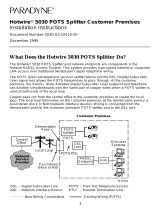 Paradyne 5030 Specification
Paradyne 5030 Specification
-
 Paradyne Hotwire 5446 User manual
Paradyne Hotwire 5446 User manual
-
 Paradyne Hotwire 5216 User manual
Paradyne Hotwire 5216 User manual
-
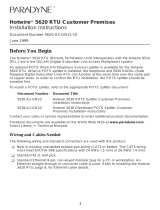 Paradyne 5620 User manual
Paradyne 5620 User manual
-
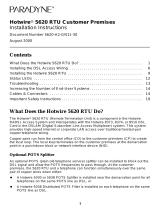 Paradyne 5620-A2-GN11-30 User manual
Paradyne 5620-A2-GN11-30 User manual
-
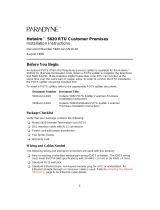 Paradyne Hotwire 5620 Installation Instructions Manual
Paradyne Hotwire 5620 Installation Instructions Manual
-
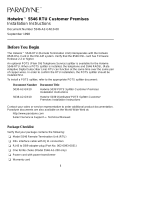 Paradyne Hotwire 5546 Installation Instructions Manual
Paradyne Hotwire 5546 Installation Instructions Manual
-
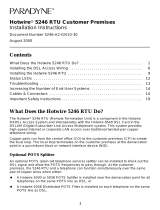 Paradyne HotWire 5246 Installation Instructions Manual
Paradyne HotWire 5246 Installation Instructions Manual
-
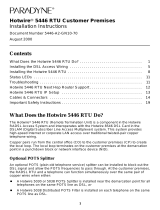 Paradyne Hotwire 5446 Specification
Paradyne Hotwire 5446 Specification
-
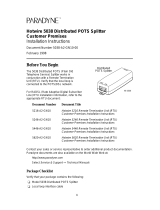 Paradyne 5038-A1-00 User manual
Paradyne 5038-A1-00 User manual





















